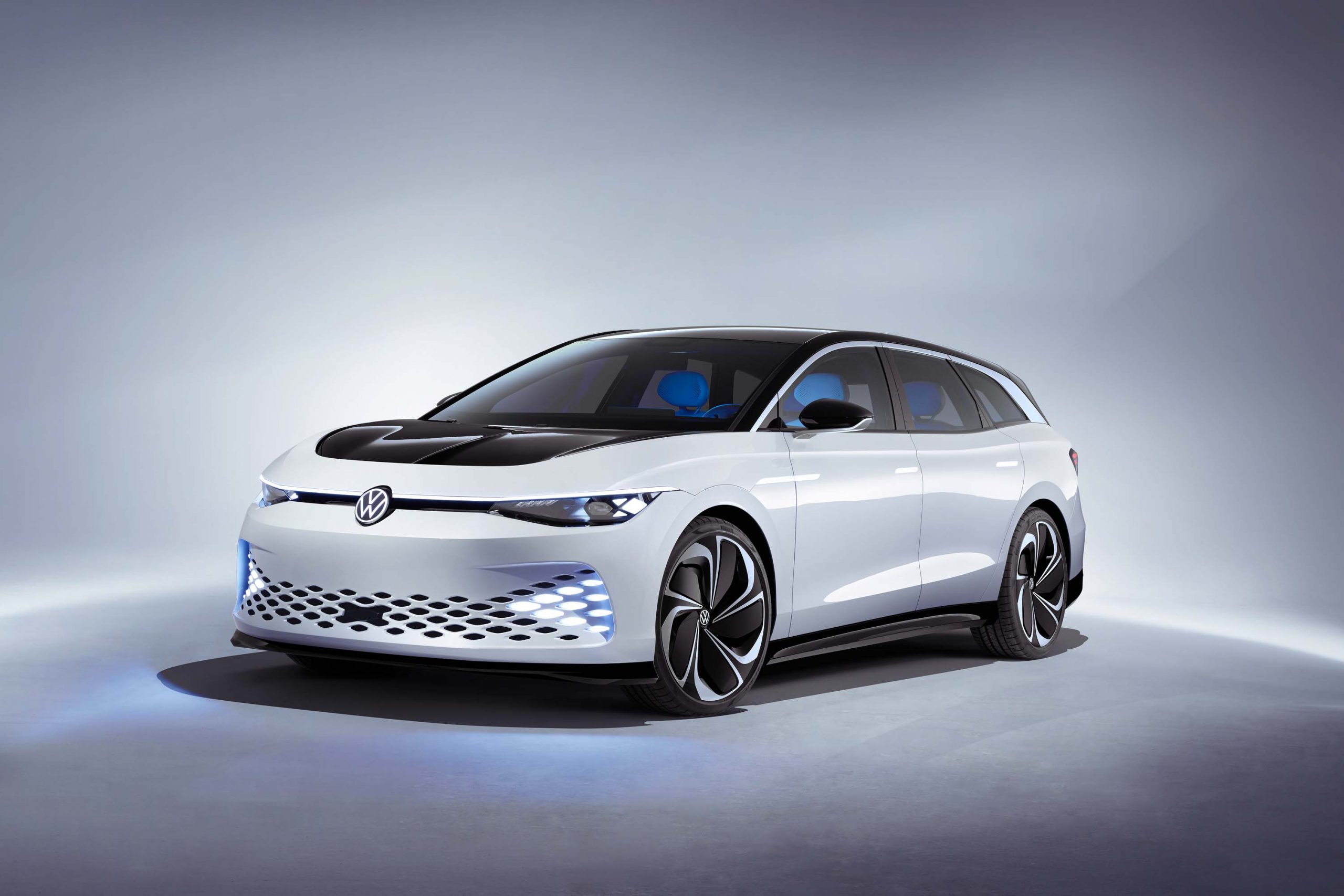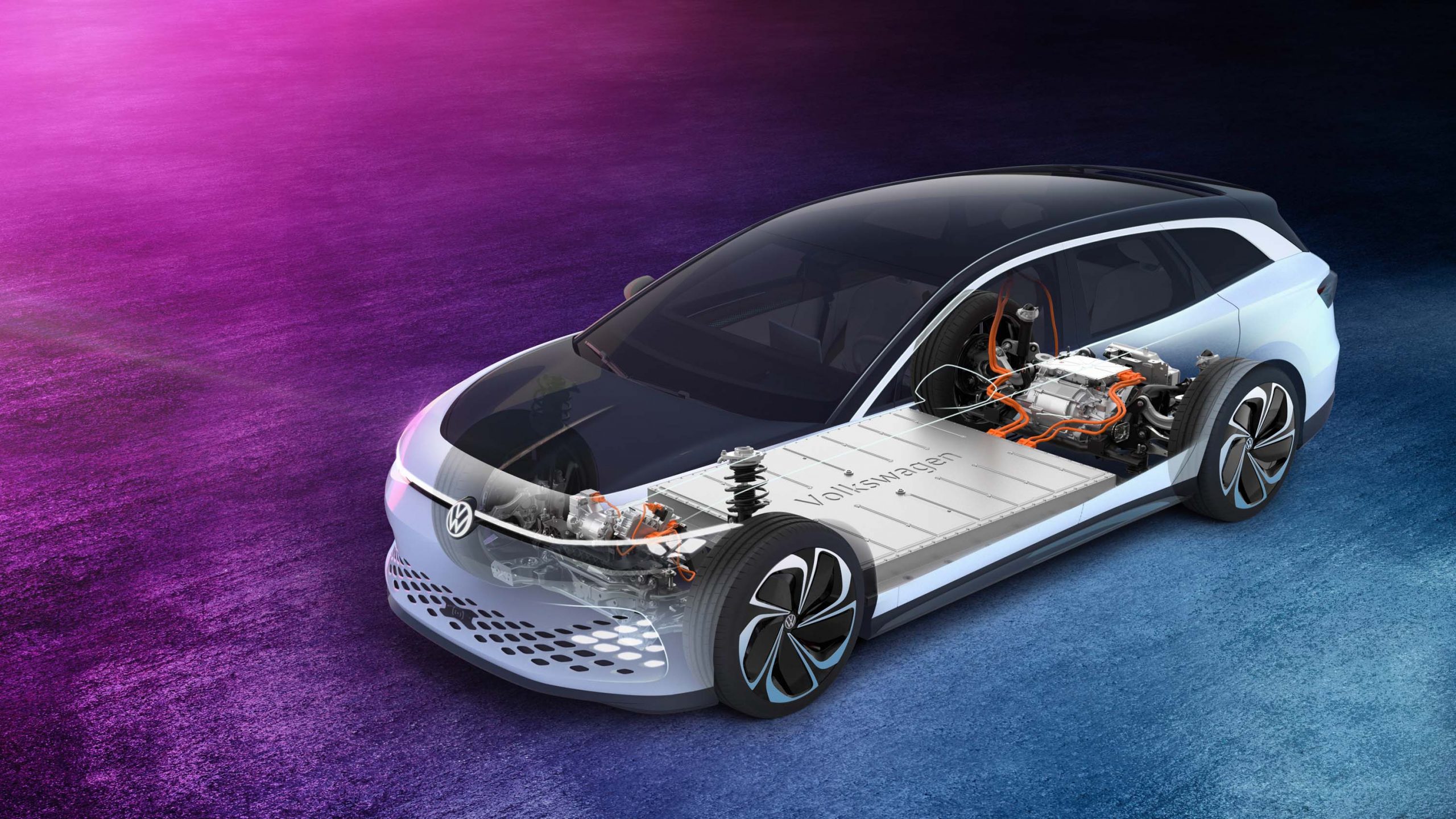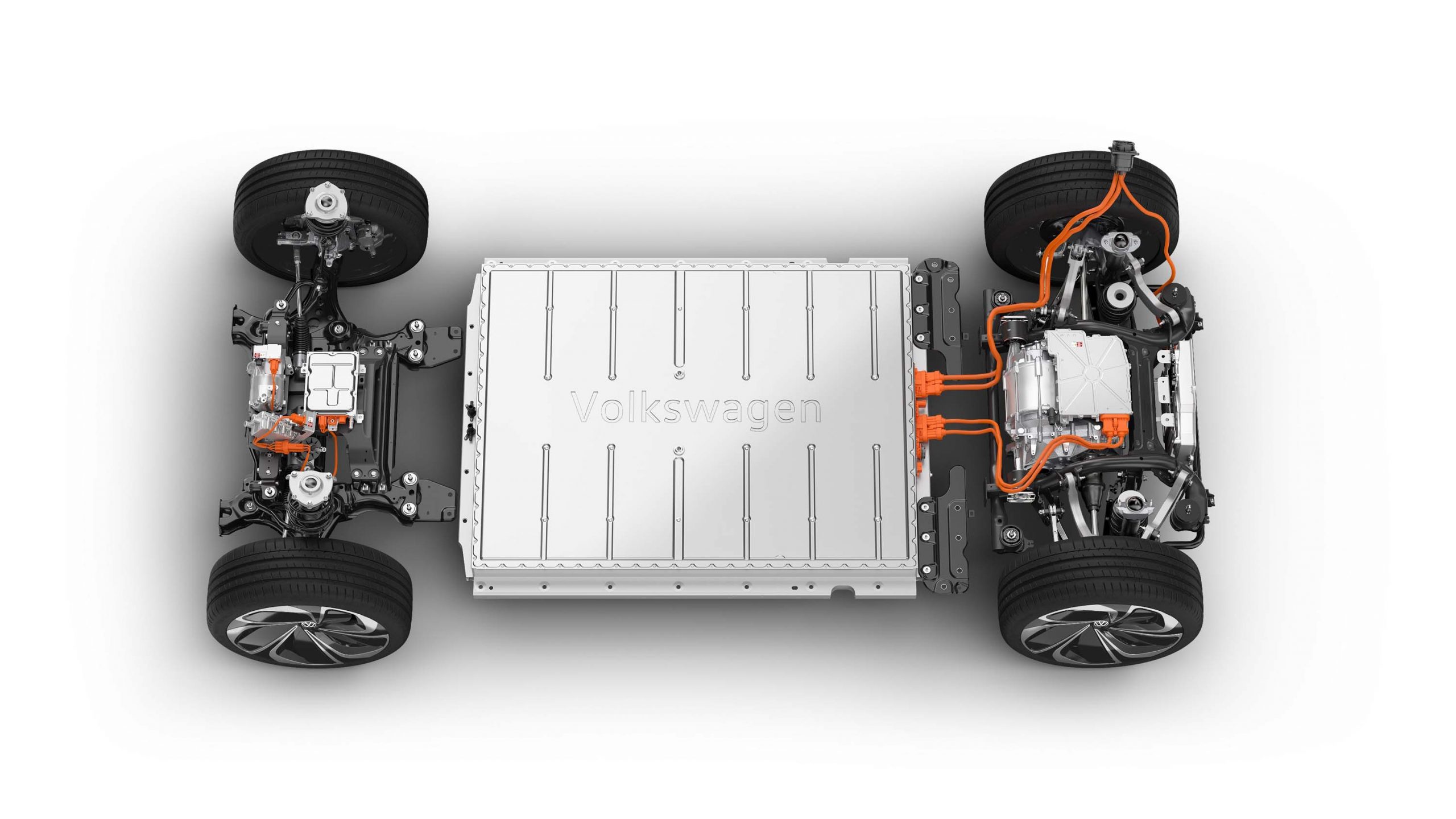Volkswagen I.D. Space Vizzion Concept makes global debut at the Petersen Automotive Museum in Los Angeles

- ID. SPACE VIZZION is seventh concept built off the MEB platform
- Vehicle previews a potential production car for Europe and North America
- Super aerodynamic design has a drag coefficient of just 0.24
- Drivetrain has an 82 kWh battery, gives a range of up to 300 miles
Los Angeles, CA — The Volkswagen ID. SPACE VIZZION electric concept combines the aerodynamic design of a Gran Turismo with the spaciousness and versatility of an SUV. With an 82 kWH battery and an incredibly low drag coefficient of 0.24, the vehicle has a range of 590 kilometers on the WLTP cycle and a predicted range of up to 300 miles on the EPA cycle. The seventh member of the ID. concept family, the ID. SPACE VIZZION previews a potential production car for Europe and North America.
The concept car is manufactured on Volkswagen’s modular electric drive matrix (MEB), as are all ID. family models. This creates an entirely new package as the electric drive components are extremely compact and the battery is integrated into the vehicle floor to save space, making it possible to alter a vehicle’s overall architecture. The concept car is fitted with a rear-mounted, 275-horsepower motor, but a second motor could be fitted to give all-wheel-drive capability and a total output of 355 hp. The ID. SPACE VIZZION is 195.2 inches long, 60.2 inches high, and 74.7 inches wide.
EXTERIOR DESIGN
Since electric vehicles don’t need a radiator or space for an engine, this creates new design freedom. In the case of the ID. SPACE VIZZION, the designers and engineers have taken advantage of this freedom to optimize the aerodynamics—in this case, to reduce the coefficient of drag (Cd) to 0.24—and thus increase the efficiency and range. Air flows under a horizontal panel between the headlights and over the extremely low hood, before being directed to the rear, where there is another horizontal panel over the tailgate that allows air to flow under it.
The hood has a high-gloss black paint finish, appearing to blend into the tinted windshield and the black tilt-and-slide panoramic sunroof. This underscores the sporty design of the ID. SPACE VIZZION. The air also flows into ducts in the front bumper, where it is also directed rearwards. The vents in the bumper and the hood panel have been designed as functional features, but are also unique design elements.
The lighting at the front is a definitive design feature. A slender white light strip extends out to the left and right of the illuminated white VW logo, reaching across the front end and into the fenders and side body. Visually, this strip continues intermittently to the rear end of the vehicle.
The IQ.LIGHT LED matrix headlights are interactive, and feature lamp modules that are seamlessly integrated into the bumper. Additional honeycomb-style LED daytime running lights that are an ID. family design cue are located in the sides of the headlamp modules and in the bumper. On the outer side of the bumper, they also act as X-shaped turn signals. The vehicle features a small, black front splitter that blends into the side sills and the rear diffuser, helping to further optimize the aerodynamics.
The extra focus on the aerodynamics also influences the design of the vehicle’s side panels. There are no conventional door handles to interrupt the airflow. Instead, the ID. SPACE VIZZION features illuminated touch surfaces which light up as soon as the car’s Keyless Advanced function detects someone approaching with a vehicle key or a synchronized mobile key on a smartphone. When the person makes contact with the touch-activated surface, the light pulsates, the touch pad vibrates, and the door opens.
The light surfaces for opening the doors represent a continuation of the front light strip. In the lower section, the clean, seamlessly merged fender and door surfaces, as well as the design of the new 22-inch aluminum-alloy wheels, have a positive impact on the aerodynamics. The wheels, designed with five aero flaps in the style of a turbine, are flush with the wheelarches to avoid any interruption of the airflow.
The visually striking tornado line is a gentle undercut, reflecting the precision of the design. The powerful shoulder section above it makes the car appear bolder and more dynamic. The roof is painted in a high-gloss black to contrast with the Saintly Blue Pearl Effect paint—a new metallic white with shimmering blue and violet pigments—and the lateral line of the roof features an aluminum appliqué, which will be a typical feature on many future ID. models.
Form and function also create an aerodynamic alliance at the rear of the vehicle. One of the dominant elements is the roof spoiler, which spans the roof like a bridge and opens out at the bottom, allowing the air to flow both above and below the spoiler. This layout reduces turbulence and optimizes airflow.
The roof spoiler, spoiler lip and diffuser work together to reduce turbulence at the rear end and help to optimize the vehicle’s range. The transparent red light strip extends around the entire rear section and through the LED taillight clusters, which also double as X-shaped turn signals. In the upper part of the light strip, an illuminated red line to the left and right of the illuminated white VW logo continues the circumferential lighting.
The concept car’s broad trunk lid can be opened electrically. The Easy Open sensor-controlled feature can be operated via a touch-activated surface on the trunklid itself or by moving your foot under the rear of the car if your hands are full.
All of the exterior lighting elements are activated when the driver opens the car. The VW logos at the front and rear light up white, followed by the light strips on the front section and silhouette which create a 360-degree flow in conjunction with the honeycomb lighting motifs. At the same time, additional honeycomb-style LEDs in the bumper generate a lighting effect. While this is going on, the illuminated red horizontal panel at the back is activated. Finally, a digital effect makes it look like the matrix headlights are opening like eyes. Conversely, a goodbye sequence is initiated as soon as the car is locked from the outside.
INTERIOR DESIGN
Three aspects characterize the interior of the new ID. SPACE VIZZION: excellent use of space, sustainable materials, and completely intuitive controls. Together, these create the interior of the future. For the first time, all driving information is displayed primarily in the highly visible Augmented Reality headup display (AR HUD).
In the ID. SPACE VIZZION, the AR HUD replaces the traditional cockpit, which now becomes a secondary mini display showing only basic information. All information, entertainment, comfort, online functions, and vehicle settings are grouped together on a 15.6-inch touchscreen which appears to hover in mid-air.
Opening the doors takes you into an open space—an interior that is more like a luxury vehicle than a midsize car. The concept car has four seats, but a production vehicle with three rear seats is also conceivable. Between the seats, there is a large fold-out center console with storage areas, drink holders and USB-C ports.
On the new ID. models, sustainability doesn’t just cover the electric drivetrain, but also the materials used in the vehicle. That is why chrome-like paint is used in place of chrome, and why the seats, cocoon-like door trim, and center console armrests are covered with the new, visually appealing and tactile AppleSkin™ material.
This innovative material feels as comfortable as leather but actually consists of a proportion of residual matter from apple juice production. It is currently possible to replace 20 percent of polyurethane with apple leftovers using a process that was developed in-house especially for this purpose.
Plastic decorative inserts and film will no longer be used in the ID. models. These will also be replaced by AppleSkin™, as used in the SPACE VIZZION concept. A future version of AppleSkin™ will feature a metallic surface and will be illuminated by ambient lighting. There is a 20.7 cubic feet luggage compartment behind the rear seats, which is more than a match for many SUVs. The compartment is fitted with a fold-up loadbed, which houses two electric longboards beneath it.
Volkswagen’s ID. SPACE VIZZION heralds the dawn of the all-digital cockpit. The straightforward logic of the controls is reflected in the new lightness of the interior design. You can create a bespoke visual appearance in the interior using ambient lighting with a spectrum of 30 colors. For the first time ever, individual colors can be assigned to touch-activated surfaces in the central infotainment system for functions such as media or phone. Natural voice control is another important tool for operating the vehicle.
The new multifunction steering wheel is equipped with capacitive touch panels. In a radical departure, the right-hand steering column switch now becomes a shift lever. And it is easier and more intuitive than ever before—turn the switch one notch forward out of the neutral position (N) to activate drive mode (D); turn it again to activate energy recovery mode (B); Park (P including parking brake) is activated by pressing the side of the steering column switch. Because the gearshift function is now on the right, the windshield wiper function migrates to the left-hand steering column switch for the first time ever in a Volkswagen.
The driver automatically and intuitively takes key information from the ID. Light—an interactive light strip between the A-pillars. The ID. Light also provides the vehicle with a way to give feedback, by greeting the driver upon entry (welcome scenario); indicating that the electric motors are operational; saying goodbye when the driver leaves the vehicle (goodbye sequence); interacting visually with voice control to help the driver; and displaying important information from the assistance systems in the driver’s peripheral vision. Different colors are used depending on the function.
The ID. Light highlights the instructions issued by driver assistance systems and navigation, provides information on the battery charge level, and notifies the driver of brake prompts or incoming telephone calls. For example, in navigation, the ID. Light flashes to recommend that you change lanes, and the system can also warn the driver if their car is in the wrong lane. With voice control, the driver and front passenger receive voice feedback in the form of a light signal. The light indicates whether the voice control assistant is responding to the driver or the front passenger. Colors are also used in line with intuitive perception—green indicates a fully charged battery while red is used for braking prompts.
The ID. Light performs the following functions while stationary:
- Hello and goodbye animation
- Instruction to apply the brakes
- Lock and unlock
- Visual representation of the charging process (six elements from 0–100%)
The ID. Light performs the following functions while driving:
- Brake prompts (Autonomous Emergency Braking)
- Navigation instructions (lane changing, turning instruction)
- Assists voice control
- Incoming telephone call
- Energy-saving mode (the vehicle cannot continue travelling at higher speeds if the battery capacity falls below a minimum limit, so as to maximize the range)
The infotainment system of tomorrow not only offers totally intuitive operation, but also a high level of customization coupled with interactive online support. The Infotainment system in the ID. SPACE VIZZION uses an online connectivity unit with integrated eSIM to network with the online features and services from Volkswagen We, We Connect, and We Connect Plus.
The ID. SPACE VIZZON recognizes the driver on the basis of the vehicle key or mobile key and adjusts to their settings before heading off. The driver can go to a central home screen to set up personalized touch-activated fields (tiles) on three different levels and use these to control all the infotainment system functions. The color spectrum of the infotainment system also changes according to the selected background lighting color. If the ID. SPACE VIZZION detects a stressful situation, such as rush hour traffic jams, the system suggests switching to a relaxation mode in which a calming ambient lighting shade is activated.
The new ID. SPACE VIZZION comes with Smart Climate, which is now fitted as standard in the new Golf. The user can simply say “fresh air” or touch a corresponding touch-activated surface to get a fresh breeze blowing through the interior. Other default Smart Climate settings include “cool quickly”, “cool feet”, “warm feet”, “warm hands”, “defrost the windshield” and “quick heating.” The ventilation system can also be controlled via touchscreen.
POWERTRAIN
The ID. SPACE VIZZION exhibited in Los Angeles is powered by a 275-horsepower, rear-mounted electric motor. An 82 kWh lithium-ion battery supplies power to the electric drive motor. Power electronics on the front and rear axle control the flow of high-voltage energy between the motor and the battery. Power electronics convert direct current (DC) stored in the battery into alternating current (AC). The on-board electronics are supplied with 12 volts via a DC/DC converter.
Near ideal weight distribution (approaching 50:50) is achieved with the MEB architecture, which results in extremely dynamic and safe handling. The fully redeveloped running gear also has a significant influence on this, featuring electronic damping control, a multi-link rear suspension, and a strut-type front suspension.
In addition to the 275-hp rear-mounted motor, the ID. SPACE VIZZION can also be fitted with a 101-hp coaxial drive, which gives the vehicle all-wheel-drive capability and a system output of 335 hp. In addition, the ID. SPACE VIZZION 4Motion® can also be driven in permanent all-wheel drive.
The 4Motion version of the ID. SPACE VIZZION sprints to 60 mph from rest in just 5.0 seconds and the maximum speed is electronically limited to 109 mph. On the European WLTP cycle, the range of the rear-wheel drive concept car exhibited in Los Angeles is up to 590 kilometers. Using the U.S. EPA cycle, the projected range is up to 300 miles.
SPACE VIZZION TECHNICAL DATA
| Length | 195.2 in |
| Width | 74.7 in |
| Height | 60.2 in |
| Wheelbase | 116.7 in |
| Wheel/tire size | 9J x 22 / 255/35 ZR 22 |
| Flexible open space | Four seats (alternatively five) |
| Luggage compartment volume | 20.7 cu ft |
DRIVE SYSTEM / RANGE / DRIVING PERFORMANCE
| Drive | Rear-wheel drive (alternatively 4Motion) |
| Electric motor at rear | 275 hp; 406 lb-ft |
| Electric motor at front | 101 hp; 111 lb-ft |
| Rear-wheel drive system power | 275 hp |
| 4Motion system power | 335 hp |
| Gross battery capacity | 82 kWh |
| Net battery capacity | 77 kWh |
| Range (WLTP/EPA) | up to 590 km / 300 miles |
| Charging capacity | 150 kW (DC) |
| Charging time | up to 80 % at 82 kWh Approx. 30 min |
| 0-60 mph | 5.0 sec (4Motion) |
| Maximum speed (limited) | 109 mph |





























